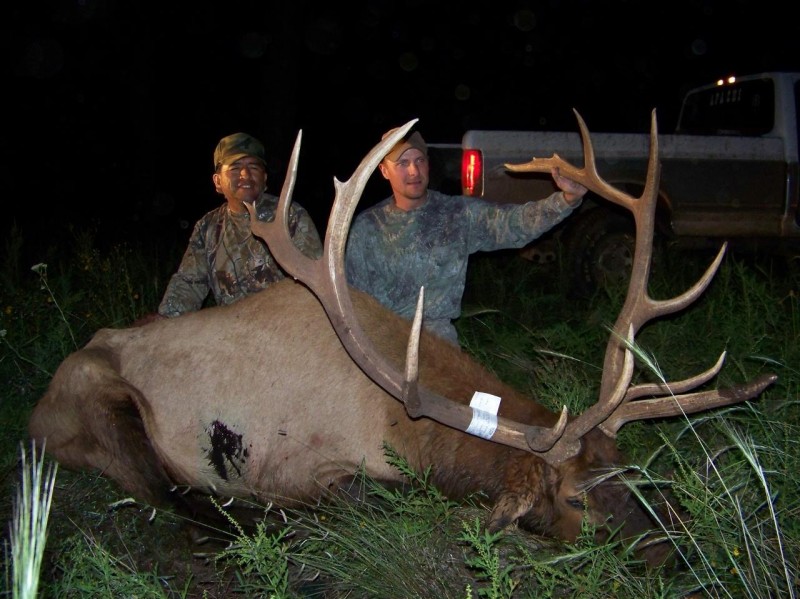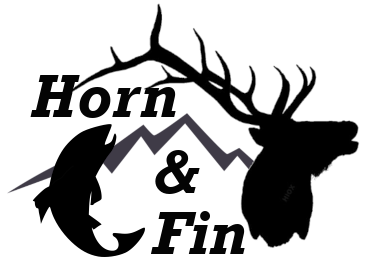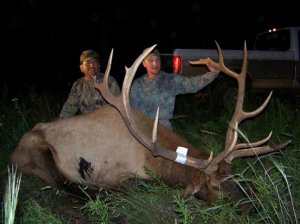- Hunting
- Discounted Guided Hunts
- New Mexico Elk, Coues Deer, Javalina Hunts San Carlos Apache Reservation
New Mexico Elk, Coues Deer, Javalina Hunts San Carlos Apache Reservation
Hunt Info
Contact Info
Big Game
Small Game

With such a broad array of animals you will be hunting 1.86 Million acres with altitudes from 2,400 feet to as high as 8,282 feet. You will be able to hunt Elk, Coues Deer, Turkey, Mountain Lion, Bear Javelina, Antelope, Desert and Bighorn Sheep. You will be hunting the San Carlos Apache Reservation by Globe New Mexico with an Apache Outfitter.
Living and hunting there all of his life he hunted there many years before any of these animals were even born. Since then he has made some major holes in their family trees with his successful hunting techniques. The area is managed for quality, not quantity so record class animals are no unusual.
With terrains that range from low desert with cactus and grass to high desert that is scattered with rim rock and steep faced slopes that rise to the upper elevations. The last type of terrain we have is the high country meadows and ponderosa pine and fir trees with scattered aspen and many meadows to accent the scenery.
Lodging is usually wall tents and wood stoves within 2 miles of where the game has been scouted. Most of the hunting is spot and stalk because of the terrain but depending on the habitat and the animal being pursued it can be to stand and wait in a certain area for the animal that has been previously patterned to arrive.
We receive generally more moisture than most of the state of Arizona and also get plenty of snow in the higher regions on our northern half of the reservation. When the foliage is in full bloom, the landscape turns into an array of colors like no other.
Rocky Mountain Elk
The San Carlos Apache Tribe has four populations of elk (Cervus elaphus) on the Reservation. Three populations, the Drylake, Hilltop, and Nine-Mile herds are managed for trophy quality. We limit bull permits to manage an older-age class herd. The fourth population is located in the Malay Gap area is managed primarily for hunting opportunity. This region is roughly 134,000 acres in size and is located in the north-eastern corner of the Reservation. The Malay Gap herd has a small year-round residential herd, but during the winter, the area hosts a wintering population of migratory elk that come from the White Mountains to the north and the Apache-Sit Greaves National Forest to the east.
The elk herds on the Reservation are related to the Yellowstone elk herd, however there is speculation that the endemic, but thought to be extinct, Merriam’s elk may have contributed to the gene pool of elk found on the reservation. The life expectancy of a female elk is from about 16 to 18 years. Rut occurs in mid to late September with a gestation of 8.5 months. Calving occurs in late May to mud June. Age at first breeding for cows is 1.5 years and for bulls is 4.5 years. Diets include grasses, forbs, and shrubs.
The elk here on the reservation are monitored for quality rather than quantity and for this reason San Carlos has some of the world’s biggest elk ever recorded in the wild. With approx. 1 million acres that they roam freely, the elk have the best chance of becoming mature and growing to record proportions. We have 3 trophy elk units on the reservation with one being the Dry Lake unit, which is the best known. The second is the Hilltop unit and the third being the R-100 unit. All three trophy units have the potential of producing elk that score well into the 400's on the Boone and Crockett scale. The fourth elk unit we have is a unit that concentrates on a migratory herd coming from the White Mountain Reservation and also from unit 27 in Arizona. These elk usually migrate onto the northeastern areas of our reservation and can produce elk scoring high in the 300’s an average bull will score about 320 in this area.
Coues Whitetail Deer
The Coues deer (Odocoileus virginianus couesi) is a small-sized subspecies of the white-tailed deer. Its range is restricted to southern Arizona, southwestern New Mexico and northern Mexico. The San Carlos Apache Reservation is considered a premier area to hunt these deer and are managed to generate revenue from non-members. Coues deer may be harvested by Tribal members during their deer season, but Tribal members generally tend to harvest mule deer for that season.
Coues deer may be found throughout the reservation. Pre-dominant areas with chaparral, Manderean evergreen, or oak-juniper vegetation in adjacent to the areas of rough, steep, and broken terrain. The highest densities are in the Santa Theresa Mountains, the Mescals, the Salt River breaks, and along the Nantac Rim. Life expectancy of a Coues Deer is around 11 years. The rut occurs from late December to mid January with a 7 month gestation and fawning occurring form July to August. The average number of young is 1.3 fawns. Diet is composed of forbs, shrubs, grasses, and acorns.
The Coues is a deer that any hunter won't soon forget if he ever gets the chance to pursue this animal. It has become a favorite among hunters to harvest as it has fast become the hardest animal to hunt in North America. Most hunters who come here to chase the Coues soon realize how hard it can be to even locate an animal in the open landscape. These animals blend in so well and are gray from head to hoof. It's this unique coloring of the animal that makes it a tough animal to spot at any distance. We have 5 units open for the Coues whitetail and if you hunt hard enough you can harvest an animal scoring well into the record books.
Black Bear
Black bears (Ursus American us) are found throughout the Reservation in all habitat types. They appear to be at higher densities in the northern portion of the Reservation, in areas occupied by timber and associated woodlands. Bears are omnivores; eating a large variety of plant species (grasses, fruit, berries, and mast), insects, and meat (both carrion and prey). Black bears may live up to 20 years.
Breeding first occurs around 3.5 years in females. Females are bred in the spring, but implantation of the embryo is delayed until fall, just before hibernation with a Gestation period lasting 3 to 4 months. Females breed at 2 year intervals.
Currently, we do not attempt to estimate the population size of black bears on the reservation. There are no restrictions on the number of bear tags issued to Tribal Members for the spring hunts and for the two fall hunts. Non-members can hunt bears at the same time as tribal members; hunts are divided into five main hunting units (A, B, C, D and R-100). Some of the regulations that apply to specifically to bears is that baiting is illegal, guides are not required except for R-100.
Hunting the black bear is an experience one will rarely have trouble remembering. With a good population and habitat for the black bear they are sure to survive well into the distant future. Bears that weigh over 400 lbs. are almost common if one's homework is done correctly. Several bears have been taken over 500 lbs! With 3 different hunts and 5 units available for the black bear, you will find that the San Carlos offers so much to the hunter pursuing the elusive black bear.
Antelope
There are two major populations of pronghorn antelope (Antilocapridae Americana) on the reservation. One resides on Big Prairie, and the other on Ash Flats.
Antelope life expectancy is approximately 10 years. The rut is in September with a gestation of 8.5 months and fawning occurs in late May and early June. The doe’s will first breed at 1.5 years and the bucks at 2.5 years of age. Then on the average produce 1.6 fawns per year. Antelope diet includes forbs, shrubs, and grasses.
We have 2 units currently for the antelope and each has it's own prime animals and herds. With a habitat that is typical antelope country, one can spot and see many bucks with horns over 18 inches! Many trophy antelope have been harvested from both units and most have scored well enough to make the record books. But a limited number of tags will prove the hardest part of the hunt will be to purchase a tag. When one does get a tag, they will find that the areas holding antelope are largely undisturbed and can make for a memorable hunt.
Turkey
The Merriam’s turkey (Melaegris gallopavo) is found on the forested portions of the reservation including the Natanes Plateaus and other associated woodlands. Life expectancy of turkeys is about 6 years. Males average about 18 pounds in size, while hens range between 8 and 12 pounds. Breeding first occurs at 2 years of age for both sexes. The breeding season is April to May with hatching occurring in May-June. Clutch size is variable, often between 8 to 12 eggs with incubation lasting 28 days. Diet is highly variable including, acorns, seeds, and insects.
We currently have three season for turkeys on the reservation, two in the spring and on in the fall. The spring seasons are for toms only while the fall hunt is an either-sex tag. The spring season overlap for members and non-members, while the fall season for Tribal members overlaps with the Tribal deer season, and the fall season for non-members is usually set prior to Thanksgiving.
San Carlos Apache Reservation has some of the best turkey hunting in the world. With a population that increases each year the hunter can find himself surrounded by several toms and can experience the gobbles up close and personal. This is also a great hunt for the beginning hunter as the hunts are fairly easy and the hunter will have plenty of down time in camp that can be utilized fishing in the many stock tanks we have in the area.
Mountain Lion
The elusive mountain lion can be one of the most sought after animals by hunters in the field. With a population that is steadily increasing, the Apache Tribe offers a complimentary tag for a mountain lion on the big game hunts with exception of the special trophy hunts. Fees are reasonable and one can find himself in back country so remote hardly a person has set foot in the same region. It is a hunt one will not soon forget.
Javelina
Javelina (Tayas)
(Note: the guide prices are extremely reasonable but the Reservation Big Game hunting licenses are quite high. On another note the bird hunting is great and the numbers are high.)
We have a wide distribution across the Reservation, being most abundant in the oak/juniper and juniper woodlands interspersed with desert or grassland habitats. Highest densities are found in portions of A, B, and D. Javelina’s have a life expectancy of 9 years. They are capable of breeding at any time of year with gestation of 5 months. The age of sows at first breeding is 10 months. Javelina’s are highly social and will move in groups of around 10 individuals. Javelina’s are omnivores, and particularly favor prickly pear cactus.
We monitor Javelina through our hunter questionnaire survey. We do not attempt to estimate the population size and demographics directly. Both tribal member and non-member Javelina hunting season are concurrent.
The Javelina is an animal that can be an exciting hunt in the making. Most avid bow hunters will hunt the Javelina and first time hunters as well. The Javalina inhabit most areas of our homelands so finding them can be quite easy but spotting them may be a different story. Whatever the circumstance, a hunter will find that this is an animal that can make for some memorable weekends with young children and a first step to the bigger game animals we have to offer.
Desert & Rocky Mtn. Bighorn
Desert bighorn sheep (Ovis canadesis) are found in the southwestern portion of the reservation within the Ash Creek-Devil’s Canyon area in Unit D. This population is an offshoot of the Aravaipa herd with exchanges of individuals between these areas reportedly occurring frequently.
Desert bighorn sheep have a life expectancy of 13 years. The rut occurs from August to October. Gestation is 6 months and lambs are born from February to April. Ewes first breed at 2 years and the rams breed at 4.5 years. Diet includes grasses, shrubs, and forbs.
The bighorn sheep has amazed many hunters alike for generations. Most hunters also realize that to harvest one they not only have to be a great physical shape but also have the funds to pursue the animal. If one ever has the chance at one of these magnificent creatures, San Carlos offers some extremely remote areas for the sheep and trophy quality animals.
The San Carlos Apache Indian Reservation also has the desert mule deer, although, it has been reserved only for tribal members of the San Carlos Apache Tribe. Some of these mule deer can reach into the 200 inch class and have spreads over 30 inches. So you will find that we have so much to offer for the hunter and a land of paradise like no other.
QUAIL
For the avid quail hunter, we usually get hunters who have hunted mostly gambles quail but when they hunt a day with us they have a great new understanding of the species of quail we have on the San Carlos. Hunting the mearns quail takes some effort and stamina. But after a day of hunting a bit more rugged areas for these quail one can have a good feeling of accomplishment for pursuing the ever so challenging mearns quail. Also we have the scaled quail or "blue quail". Scalies as they are most likely know around these parts, they can be a tough bird to hunt as they are great runners and usually inhabit areas wide open and grassy with many hidden rocks. They can cover several hundred yards in a single chase and can evade a hunter with ease. So when you do find a good covey you can hunt, you may have one of the best times hunting the quail. We at Apache Outdoors also like to practice good ethics and usually try not to hunt the same area twice in a single season unless the bird numbers previously were in the several hundred. But with over a half a million acres to chase the quail, it would be hard to hunt the same areas more than once in a single season.
DOVE
There are three species of dove (family Conlumbidae) found on the Reservations: Mourning (Zenaida macroura); White-winged (Zenaida asiatica); and Band-tailed Pigeon (Columba fasciata). All three species are migratory. They feed on small seeds, grains, and acorns. Hunters limit and season dates are usually adopted from the Arizona Game and Fish Regulations.
PREDATORS
Daily Predator License $10/day
Habitat stamp required $5.00
Season open all year, except during the Trophy Elk Hunts.
The Department of Recreation and Wildlife defines bobcats, coyotes, and foxes as predators for their hunting permit system. Bobcats weigh between 12 and 30 pounds and live throughout the Reservation in rough and broken terrain. Bobcat’s principal preys are cottontail rabbits and jackrabbits. Bobcat’s become sexually mature at 2 years of age, gestation lasts almost 2 months, and the litter size is between 1 and 3 kittens. Coyotes weight between 17 and 25 pounds and can be found throughout the Reservation. They are opportunistic foragers and their diet includes insects, reptiles, birds, mammals, and some plants. Breeding usually occurs in mid-winter and coyotes have a 2 month gestation period. Gray fox live in broken and wooded terrain and weight between 5 and 9 pounds and like coyotes are opportunistic foragers.
Predators can be hunted all year by both Tribal members and non-members except during the Trophy Elk Hunts. Non-members can purchase a hunting permit for $10.00/day (a habitat stamp is also required) and tribal members can hunt predators with their General Annual Hunting License (a habitat stamp is also required). Electronic calls are illegal. Predator’s populations are not directly managed by the Department. We did not conduct questionnaires to predator hunters.
MOUNTAIN LION
Daily Mountain Lion License $10/day
Mountain Lion tag $15.00
Habitat stamp required $5.00
Mountain Lion (puma concolor) are found throughout the reservation in all habitat types. Abundance and distribution appears to be primarily related to food availability. Lions are carnivores that utilize a wide range of animals for food, including deer, elk, Javelina, cattle, bighorn sheep, and quail. Life expectancy is about 12 years. Mountain lions first breed at 2.5 years for females and about 4 years for males with a gestation of 2 months. Average littler size is 2.6 kittens.
The Recreation and Wildlife Commission required all successful lion hunters to report their harvest to the Department. This data will be compiled at the end of each calendar year. Electronic calls are illegal.
Hunt ID: AZ-ElkCouesDeerJavalinaBearTurkey-All-AO-Bob
{BreezingForms:Hunt_Special_Information_Request_Form}

